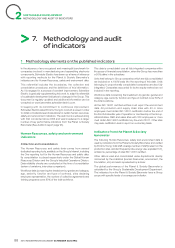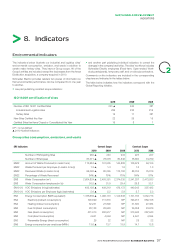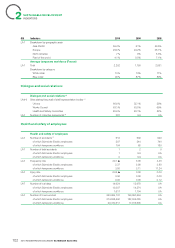APC 2010 Annual Report Download - page 97
Download and view the complete annual report
Please find page 97 of the 2010 APC annual report below. You can navigate through the pages in the report by either clicking on the pages listed below, or by using the keyword search tool below to find specific information within the annual report.
SUSTAINABLE DEVELOPMENT
METHODOLOGY ANDAUDIT OFINDICATORS
3 Statutory Auditors’ Report
This is a free translation into English of the original report issued in French language and is provided solely for the convenience of English-
speaking readers.
Year ended December 31, 2010
Statutory Auditors’ Report on a selection of environmental, safety, HumanResources
and Planet & Society Barometer indicators
Dear Sir or Madam,
Further to your request and as statutory auditors of Schneider Electric, we have performed a review allowing us to express limited assurance
that the 21 indicators about environment, safety, human resources and Planet & Society Barometer for the 2010 fi scal year, identifi ed with
the▲ symbol in the tables presented on pages 47, 54, 62, 72 and 97 to 104 of the annual report (“the Indicators»), have been prepared,
in all material respects, in accordance with Schneider Electric 2010 reporting guidelines (“the Guidelines”), summarised on pages 88 to 90.
It is the responsibility of Schneider Electric’s management team to prepare the Indicators, draw up the Guidelines and ensure that the Guidelines
are available for consultation at the group’s head offi ce.
Our responsibility is to express a conclusion on the Indicators, based on our review. Our review was carried out in accordance with the
international standard ISAE 3000 (International Standard on Assurance Engagement, December 2003). Our independence is defi ned by the
legislative and statutory texts as well as the ethics code of the profession.
The conclusion formulated below concerns only the specifi ed Indicators and not the entire sustainability report included in the annual report.
A higher level of assurance would have required more extensive work.
Nature and scope of our review
In order to be able to express our conclusion on the Indicators, we performed the following review:
•We conducted interviews with the persons responsible for the reporting on these Indicators as well as a risk and materiality analysis at
Group level. For EMEAS and North America regions, extended works were performed on safety Indicators.
•We also assessed compliance with the Guidelines and performed analytical procedures and consistency checks, as well as verifi ed, based
on sample surveys, data processing for the calculation of the Indicators and their aggregation.
•We selected a sample of four operational units according to their activities, their geographic locations, and their contribution to the group’s
Indicators and the results of prior risk analyses.
•The selected sites represent on average 7% of the total value of the Indicators (from 5% to 14% depending on the Indicators). At the
selected sites level, we verifi ed the understanding and application of the Guidelines, and verifi ed, on a test basis, compliance with the
calculation formula and reconciliation with supporting documents.
•We reviewed the presentation of the Indicators in the annual report 2010 on pages 47 to 78 and 97 to 104.
In view of the work carried out over the last six years, we consider that our verifi cation work concerning the Indicators provide a suffi cient
basis on which to formulate our conclusion, presented hereafter.
Information and comments
Regarding the reporting Guidelines defi ned by Schneider Electric for the selected data, we wish to make the following comments:
•The reporting tool One is now fully in use within North America region which removes an intermediate manual consolidation level that was
a source of errors in the past.
•Operational units have reporting perimeters not always homogeneous between Indicators and from one year to another. Specifi c attention
should be provided to the homogeneity of those perimeters and to the traceability of reported data.
•Improvements have been made regarding Guidelines formalisation and verifi cation procedures implemented at Group level for
environmental Indicators. Nevertheless, the defi nition of “training hours” indicators should precise all types of training that must be taken
into consideration.
•At Group, sites and operational units’ levels, the formalisation of controls to be performed on all security and Human Resources data as
well as their implementation could be reinforced.
•With respect to the information detailed in the methodology note presented on pages 88 to 90 and in the comments to the published
Indicators, we would like to highlight that since 2010 energy consumption and SF6 leaks data are reported monthly instead of bi-annually.
Other environmental data are gathered in June and December based on estimates (at least for the last month of each semester) and is
not systematically readjusted at year’s end.
2010 REGISTRATION DOCUMENT SCHNEIDER ELECTRIC 95
2
























